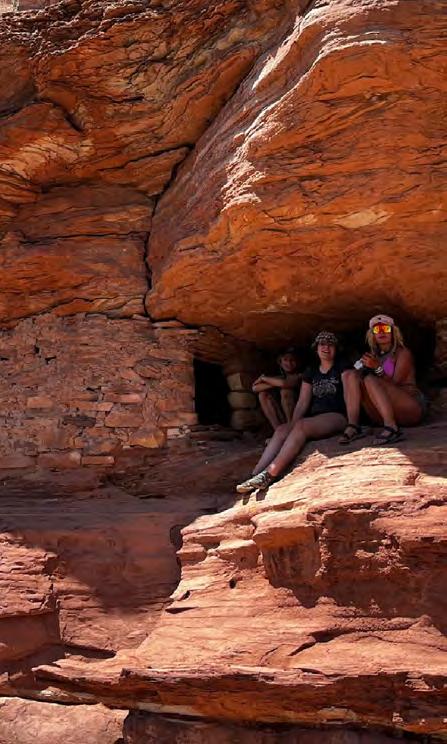
2 minute read
Rivers Run Dry
from Water in the West
After getting out of our aluminum canoes on the Green River in search of ancient Anasazi granaries, wewereabouttoclimbanauburn,orangerockyslab to get to the next level of rock, when one of my classmates spotted the small structure. The granary was a small hut constructed using sandy colored rock slabs held together by thick dried mud built into the side of a shelf of rocks. As I looked at the ancient structure, my interest in the lives of the people who lived there before us grew. What problems did they have, and were they similar to ours?
The Anasazi, or Ancestral Puebloans, inhabited the Green river hundreds of years ago before disappearing. Jared Diamond, the writer of Collapse: How Societies Choose to Fail or Succeed, stated that a drought was fatal to the Anasazi's disappearance,arguingthatbyusingdendro- chronology, scientists can now see that the Chacoan population changed with the rain. Annual corn harvests, annual tree rings and soil studies provide information about the falling groundwater levels and extreme drought. While the Anasazi's collapse may have happened many years ago,weasWesternstatesmaybemaking the same mistake today. The fall of the Anasazi echoes some of the events in current society, such as how we have had seasonsofheavyrainfallandsnow,butare stillonthevergeofawatercrisis,“aseries of good years, with adequate rainfall or with sufficiently small groundwater tables, may result in population growth, resulting in turn in society becoming increasingly complex and interdependent and no longer locally self sufficient” (Diamond, 2005, p.143). Therefore, the Anasazi couldn't provide enough water and food for their population that was growing at a fast rate during good rain years. SimIlarly, our population in the Western states is still fast growing while our water supply is quicklydwindling.
Advertisement

Paddling down the maze of stone towers and beautiful rock walls on the Green, we saw few other groups completing the same voyage as us, most of them were olderandhadalovefortheriver.Goingto a place to better understand how it helps people care about it more, paddling down theGreendidthatforme.
BeingontheGreenRiverhelpedmeunderstand whythistopicissoimportantandwhyweneed toprotecttherivernotjustbecauseitwillcome back to bite us, but if we don't we will also be destroyinganecosystem.
Our trip was a recreational paddling trip, recreationalpaddlinghasbeenaroundsincethe mid 1950s and is an industry that generates around646billiondollarsyearly.Recreationisa businessthat,likemost,needswatertorunand it shows that not just farmers and cities need water. Recreational paddling is a great way for people to see the river that is giving all of the Western states their water and cultivate a desire to protect this precious resource (Hansmen, 2019, p126-150). While we paddled down the river, we passed cliffs of rock with swirling indents, and rock amphitheaters that echoed our voices back to us. As we moved further down the river, the walls of the canyon towered high above us like skyscrapers as the blisteringsunbeameddownonourskinburning it. As the long stretches of canyon progressed dark oranges and purples streaked across the rock.
It intrigues me that this massive river is providing water for seven states. It is a strong, mighty river, but if we can't properly distribute our water, the strong mighty river we see today will grow weak and disappear, repeating history as we know it. The bottom lineisthereisenoughwaterforallofusifwe reassess and everyone makes cuts. Not just one group, state or profession has to cut their water. We should see the basin as a wholeandlearnhowtoproperlymanagethe way that we are using our water. In the beginning, water allocations were based on false math and now we need to make the corrections. Our water can be conserved if we use it sustainably and divide it equally, locally, and statewide. While we need to improve the technology we are using to be more efficient in water usage, we more importantly need to improve how we are using our water now as a society (Hansmen, personalcommunication,May22,2023).
On the jet boat out of the river, I looked out at the water's chocolate brown color as it rushed swiftly past me. I learned to love this riverafterspendingeightdaysonit.Ilooked at the rocks shaped like sculptures in a museum, perfect and made by nature. This placehastobeprotected,Ithought.











